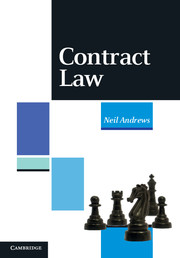Book contents
- Frontmatter
- Contents
- Preface
- Table of cases
- Table of statutes
- Table of statutory instruments
- Part I Introduction
- 1 Main features of contract law
- Part II Formation
- Part III Consideration and intent to create legal relations
- Part IV Third parties and assignment
- Part V Vitiating elements
- Part VI Terms and interpretation
- Part VII Breakdown and liability
- Part VIII Remedies for breach
- Part IX Illegality and public policy
- Part X The future
- Appendix: A who's who of contract law
- Bibliography
- Index
1 - Main features of contract law
from Part I - Introduction
- Frontmatter
- Contents
- Preface
- Table of cases
- Table of statutes
- Table of statutory instruments
- Part I Introduction
- 1 Main features of contract law
- Part II Formation
- Part III Consideration and intent to create legal relations
- Part IV Third parties and assignment
- Part V Vitiating elements
- Part VI Terms and interpretation
- Part VII Breakdown and liability
- Part VIII Remedies for breach
- Part IX Illegality and public policy
- Part X The future
- Appendix: A who's who of contract law
- Bibliography
- Index
Summary
CHARACTERISTICS OF ENGLISH CONTRACT LAW
English contract law is organised into topics, as set out in the chapter headings of this work. These form the ‘general part’ of the subject. English contract law assumed its current shape in the nineteenth century, although there was much doctrinal development or legislative change during the twentieth century (remarks to this effect by Brian Simpson, Patrick Atiyah, David Ibbetson, Michael Lobban, and Steve Hedley). As Hedley explains:
Speaking in broad terms, the Victorians invented the idea that the law will enforce contracts as such. They were given a law of contracts, but turned it into a law of contract, with general principles applicable to all agreements. The responsibility for this development is largely that of Leake [1st edition, 1867], Pollock [1st edition, 1876] and Anson [1st edition, 1879], who each produced major textbooks expounding a law of contract and not merely collecting together rules on different types of contracts. The subject matter of contract was overwhelmingly business and consumer transactions; the general principles of contract were thus largely designed for commercial work.
In modern times, Parliament and judges have consistently assumed the existence of a coherent body of general rules applicable to all types of contracts. Other legal systems organise the subject in a similar fashion, distilling general rules and doctrines of ‘contract law’, and distinguishing this unifying or shared body of law from the particular features of specific contracts, such as sale of goods, insurance, hire, employment, etc.
- Type
- Chapter
- Information
- Contract Law , pp. 2 - 16Publisher: Cambridge University PressPrint publication year: 2011
- 1
- Cited by



